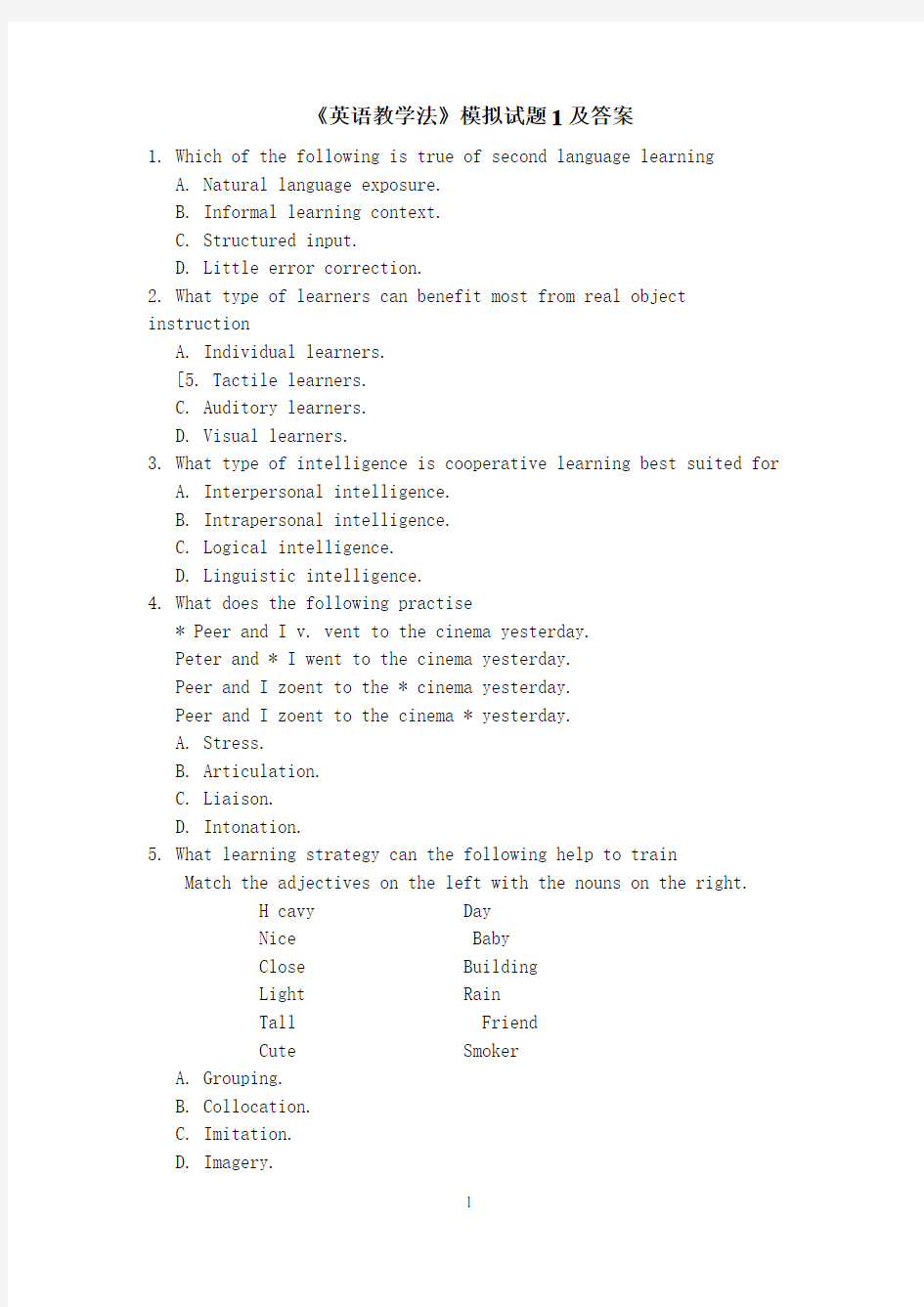英语教学法模拟试题及答案

- 1、下载文档前请自行甄别文档内容的完整性,平台不提供额外的编辑、内容补充、找答案等附加服务。
- 2、"仅部分预览"的文档,不可在线预览部分如存在完整性等问题,可反馈申请退款(可完整预览的文档不适用该条件!)。
- 3、如文档侵犯您的权益,请联系客服反馈,我们会尽快为您处理(人工客服工作时间:9:00-18:30)。
《英语教学法》模拟试题1及答案
1. Which of the following is true of second language learning
A. Natural language exposure.
B. Informal learning context.
C. Structured input.
D. Little error correction.
2. What type of learners can benefit most from real object instruction
A. Individual learners.
[5. Tactile learners.
C. Auditory learners.
D. Visual learners.
3. What type of intelligence is cooperative learning best suited for
A. Interpersonal intelligence.
B. Intrapersonal intelligence.
C. Logical intelligence.
D. Linguistic intelligence.
4. What does the following practise
* Peer and I v. vent to the cinema yesterday.
Peter and * I went to the cinema yesterday.
Peer and I zoent to the * cinema yesterday.
Peer and I zoent to the cinema * yesterday.
A. Stress.
B. Articulation.
C. Liaison.
D. Intonation.
5. What learning strategy can the following help to train
Match the adjectives on the left with the nouns on the right.
H cavy Day
Nice Baby
Close Building
Light Rain
Tall Friend
Cute Smoker
A. Grouping.
B. Collocation.
C. Imitation.
D. Imagery.
6. Which of the following is a communication game
A. Bingo.
B. Word chain.
C. Rearranging and describing.
D. Cross-word puzzle.
7. Which of the following can help train speaking
A. Listen and follow instructions.
B. Simon says.
C. Pairs finding.
D. Match captions with pictures.
8. Which of the following activities is most appealing to children"s characteristics
A. Cross-word puzzle.
B. Formal grammar instruction.
C. Reciting texts.
D. Role-play.
9. What"s the teacher doing by saying" Who wants to have a try"
A. Controlling discipline.
B. Giving prompt.
C, Eva[uating students" work.
D. Directing students~ attention to the lesson.
10. Which of the following activities is the most suitable for group work
A. Guessing game.
B. Story telling.
C. Information-gap.
D. Drama performance.
1 i. Which of the following belongs to learning outcomes
A. Role-plays,
B, Sequencing pictures.
C. Surveys.
D. Worksheets.
12. Which of the following best describes first language acquisition
A. Care-taker talk.
B. Minimal pair practice.
C. Selected input.
D. Timely error correction.
13. Which of the following seating arrangements is most suitable for
a whole class
discussion
14. What is the teacher doing in terms of error correction
"S: I go to the theatre last night."
T: You GO to the theatre last night
A. Correcting"the student"s mistake.
B. Hinting that there is a mistake.
C. Encouraging peer correction.
D. Asking the Student whether he really went to the theatre.
15. Which of the following questions can be used in the
questionnaire for assessing
participation
A. Did you get all the questions right in today"s class
B. Did you finish the task on time
C. Can you use the strategies we have learned today
D. What did you do in your group work today
II. Matching (20%)
1. Match the learning styles on the left with the type of activities
on the right. (4 points)
1) Visual learners A. Handwork
2) Kinesthetic learners B. Picture talking
3) Auditory learners C. Play acting
4) Tactile learners D. Song and music
listening
2. Match the types of intelligence on the left with the form of
learning on the right. (4 points)
1) Linguistic intelligence A. Doing hands-on
activities
2) Match and logical B. Sketching
thinking
3) Spatial intelligence C. Verbalizing
4) Bodily/Kinesthetic D. Conceptualizing
inteligence
3. Match the activities on the left with the language focus on the
right. (4 points)
